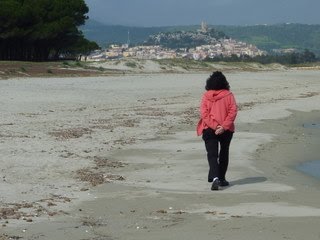 Today that area is called Barbagia, the land of the barbarians - the part of Sardinia never fully conquered by either the Carthaginians, the first historical masters of the island, or the Romans who soon followed. Later authorities didn't have much luck either, right up to the present.
Today that area is called Barbagia, the land of the barbarians - the part of Sardinia never fully conquered by either the Carthaginians, the first historical masters of the island, or the Romans who soon followed. Later authorities didn't have much luck either, right up to the present.Even within very insular Sardinia, this area remains legendary for its independent streak. Barbagians hold fast to ways of their very own, a culture more steeped in rituals stretching back to the Neolithic era than any of more modern times. The dominant language is Sardo, a tongue so ancient that it has much more in common with Latin than modern Italian. Ironically, it's also the area of the island commonly associated with the most internationally famous of Sardinian writers and artists - Deledda, Nivola, and Delitala - many internationally known, who drew deeply upon this ancient culture for their inspiration, even as they fled its chronically harsh poverty and insularity.
Today Barbagians have it quite a bit better. Modern transport, communication and conveniences - plus Italy's generous social safety net - have taken the harsh edge off daily agrarian life. Also, the international popularity of Sardinia's famed Pecorino cheeses has significantly bolstered the economics of the formerly subsistence-only shepherding business. Meanwhile, they get to keep their pristine mountains and rivers, and their unhurried existence in the least densely populated place in western Europe.
Recently, Barbagians have also become more willing to share their traditional folk arts with outside tourists, who increasingly flock to Barbagia's many and varied local festivals and patronize the local artists and musicians. Some of the internationally known ones include the haunting Tenores di Bitti, the mythic masks of Mamoiada, and the powerful murales of Orgosolo. We'll tell you more about our visits to specific Barbagian towns in later posts.







Beautiful pictures!!Really makes us want to visit one day! Enjoy!!Marie and Nick.
ReplyDelete